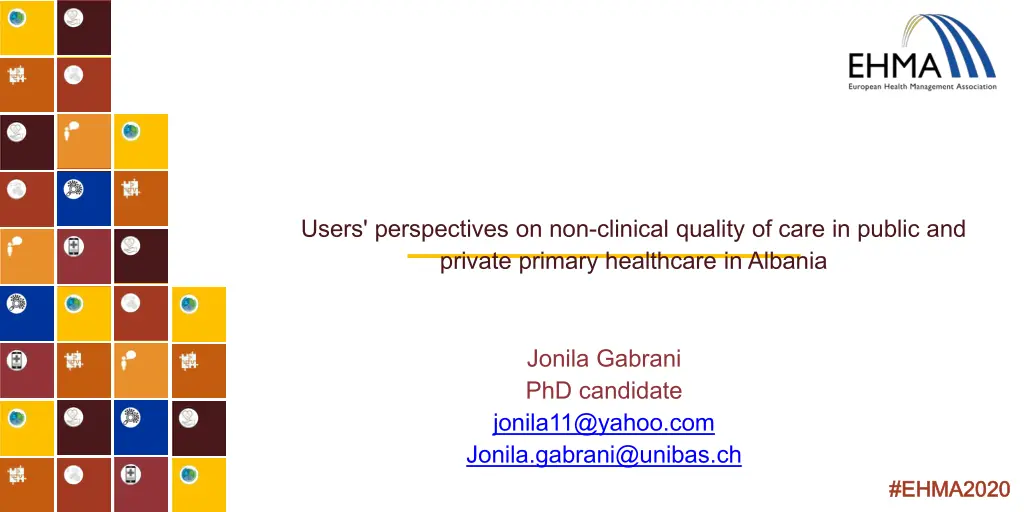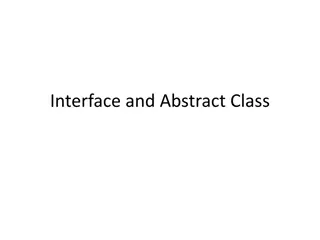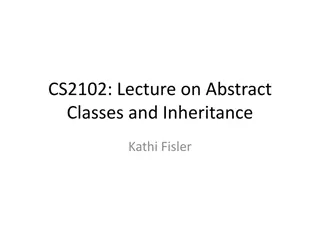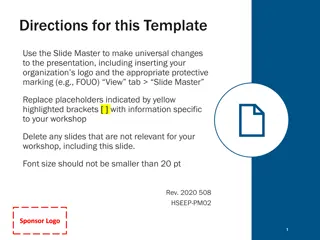
Non-Clinical Quality of Care in Albanian Healthcare
Analyzing the non-clinical quality of care in public and private primary healthcare settings in Albania, focusing on patient perspectives, health system responsiveness, and socio-demographic characteristics. The study aims to understand the impact of quality of care on adults and elderly with non-communicable diseases (NCDs) in Albania, a post-communist country in Southeast Europe. Key factors include patient-centeredness, health system responsiveness, and the provision of quality services in primary healthcare facilities.
Download Presentation

Please find below an Image/Link to download the presentation.
The content on the website is provided AS IS for your information and personal use only. It may not be sold, licensed, or shared on other websites without obtaining consent from the author. If you encounter any issues during the download, it is possible that the publisher has removed the file from their server.
You are allowed to download the files provided on this website for personal or commercial use, subject to the condition that they are used lawfully. All files are the property of their respective owners.
The content on the website is provided AS IS for your information and personal use only. It may not be sold, licensed, or shared on other websites without obtaining consent from the author.
E N D
Presentation Transcript
Users' perspectives on non-clinical quality of care in public and private primary healthcare in Albania Jonila Gabrani PhD candidate jonila11@yahoo.com Jonila.gabrani@unibas.ch #EHMA2020 #EHMA2020
Why talk about care access&quality among adults and elderly with NCD in Albania? Albania -South-east Europe, post-communist country (1991) Primary Care Health Center, Health Post - rural -About 85% of the overall burden of disease is Polyclinic-urban attributable to NCDs. Aging population Secondary Care Towards UHC, a free check-up program, removal of fee, reimbursed medicine. Regional Hospital Municipality Hospital -Private providers in urban areas and major cities duplicate PHC service? Tertiary and Emergency Care Accreditation in place since 2009 University Hospital National Emergency Center #EHMA2020 #EHMA2020
Why non-clinical quality of care? -Patient Centeredness Jonila Gabrani 1,2 *, Christian Schindler,1 and Kaspar Wyss 1,2 1. Swiss Tropical and Public Health Institute, Basel, Switzerland; 2. University of Basel, Basel, Switzerland; #EHMA2020 #EHMA2020
AIM to analyze non-clinical quality of care of primary healthcare services in public and private settings METHOD 1. A health facility survey Public health centers (HC) in rural and urban areas in two regions (38 HCs), and private outpatient clinics in urban areas of Fier (5 HCs out of 8). -Questionnaire on patient s perception -Data collection, August 2018 2. Main outcomes: a) Mean values-4 point Likert scale b) Associations with sociodemographic characteristics 3. Data Analysis: Linear mixed models. Cronbach s alpha #EHMA2020 #EHMA2020
Instrument Health system responsiveness questionnaire Private provider =better quality? Domains 1. Respectful treatment 2. Health providers communication 3. Coordination of care 4. Personal information (Confidentiality) 5. Ability to choose doctor 6. Involvement in Decisions (Autonomy) 7. Prompt attention 8. Clean surroundings(Quality of basic amenities) #EHMA2020 #EHMA2020
Results Socio-demographic characteristics Study population: n=954, accepted to be interviewed, a response rate of 88%. Female: 58% female visits Unemployed 33% of the participants 50% had basic education private outpatient clinics in urban areas provided services to younger patients (57% of patients were <60 years) who perceived themselves as having good health. #EHMA2020 #EHMA2020
Results Rating of non-clinical care quality by patients, mean values Quality has no age, no gender, no facility ownership Private outpatient clinics better at confidentiality (3.77 vs 3.38, p = 0.04) Best rated domain Worst rated domain Urban Public Urban Public Communication and quality of basic amenities (3.70 vs 3.02, p < 0.001). Choice Urban Private Urban Private Dignity Coordination of care Urban public clinics PHC better at coordination of care (2.90 vs 2.12, p < 0.001) Rural Public Rural Public Communication Promptness Total population Total population Communication Rural settings: highermean values. Coef.0.2, p=0.01 Choice/Prompt attention #EHMA2020 #EHMA2020
Results FIGURE 1 Importance and associated responsiveness of attributes of non-clinical quality of care (x) patients experience, interactions (y) patients expectations #EHMA2020 #EHMA2020
Limitations! -self-reporting -validated -3 not consent priv. -private-urban area - Tirana? Closing points: non-clinical quality of care Little variations across urban public and private sector. Communication and dignity rated as most important , were also well performed ones, in both settings. Overall, choice , prompt attention and coordination of care were among the lowest rated. Lack of awareness on autonomy. THANK YOU FOR YOUR ATTENTION For more information: #EHMA2020 #EHMA2020 jonila.gabrani@unibas.ch






















